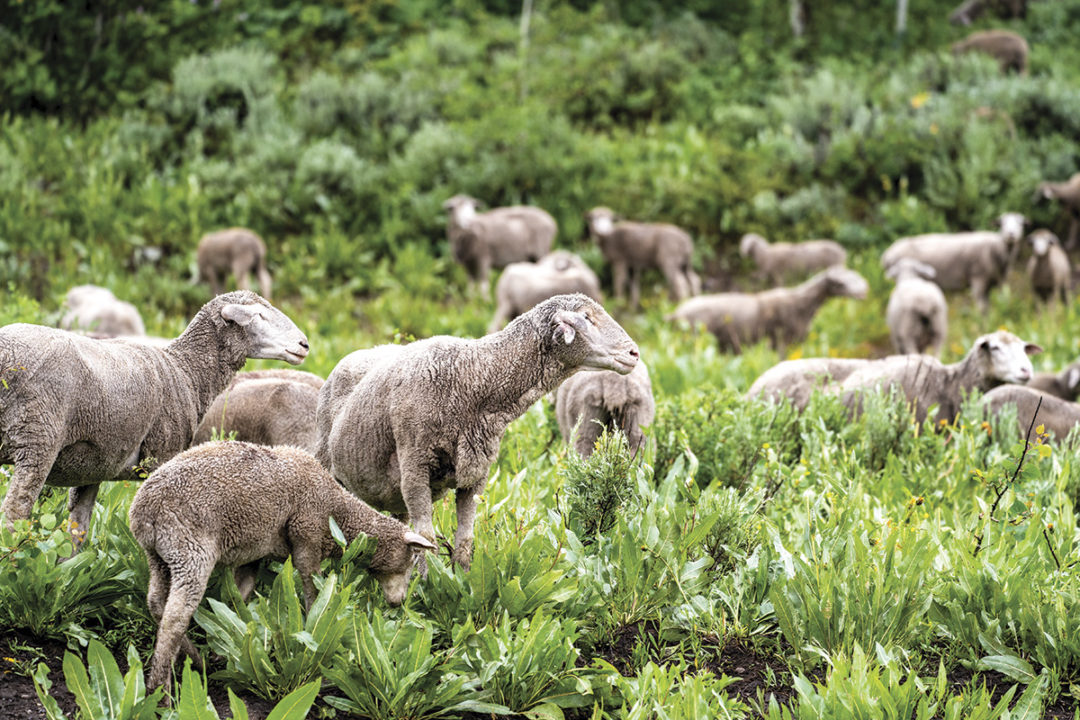In early June 2022, Wilder sheep rancher Frank Shirts had 143 ewes and lambs fall to their death after being chased by wolves near Shaw Mountain, just outside of Boise. According to the USDA reports, two adult wolves chased the pack of sheep into a steep gully, where they piled up and fell to their death, suffocating.
Shirts runs sheep flocks, from the low country in Wilder to the high country in the Boise and Payette National Forests every year. In the spring, flocks navigate through the Boise foothills.
The wolf attack occurred during daylight hours, and the wolves did not consume the sheep.
Two of Shirts’ Peruvian sheep herders who stay with the sheep 24/7 managed to chase off the two wolves. Two Great Pyrenees guard dogs that were watching over the herd ran for cover.
“For this incident, the herders witnessed two wolves chasing the sheep down a ridge, and Wildlife Services confirmed two sets of wolf tracks in the location of the incident,” says Katie Oelrich, biologist for the Idaho Department of Fish and Game (IDFG). “In response, Idaho Fish and Game issued a request to USDA Wildlife Services to lethally remove the wolves in the area if they could be located. After multiple flights of the area, the wolves were not found, and the sheep had moved out of the area where the incident occurred. We know that wolves are present on the Boise Front. This occurred in Unit 39, which is an area in which we have chronic livestock depredation events (however, no depredations in Unit 39 in the calendar year 2021). Wildlife Services removes on average six or seven wolves annually from Unit 39 in response to livestock depredation.”
“The Idaho Fish and Game Commission and the Idaho Legislature in recent years have liberalized wolf hunting and trapping seasons in an effort to reduce conflicts in areas where chronic livestock depredations occur. As you’re aware, we have expanded seasons and methods of take in GMU 39, and this unit has extended control actions to address depredations,” says Oelrich.
“Over the winter, the Wolf Depredation Control Board approved additional radio-collaring and removal. IDFG and Wildlife Services worked cooperatively to implement the operation. The fixed-wing contractor scouted prior to the capture operation and located areas of wolf activity in the identified priority areas. In Unit 39, most of the tracks and individuals were located on the north side of the units. One wolf was removed, and one collar added, supplementing the currently collared wolf pack,” Oelrich says.
The U.S. Fish and Wildlife Service's 1987 recovery plan for wolves in the northern Rocky Mountains included reintroducing them in central Idaho in 1995 and 1996. The state of Idaho has the most wolves in the Rocky Mountain West, with a population of about 1,500 animals, “but that is the population estimated in the summer camera survey. During 2019-21, Idaho’s wolf population fluctuated around an average of approximately 1,270 wolves at the November midpoint from 2019-21, from a high in May of about 1,600 individuals to a low in April of about 850 individuals during the annual cycle of reproduction and mortality,” says Oelrich.
She continues, “Montana estimated wolf population appears to have peaked to stabilize at around 1,160 wolves, estimated at the end of December 2022. Montana’s wolf population is slightly lower than Idaho, but it’s close.”
Livestock compensation
“Ranchers are compensated for kills confirmed by a Wildlife Services Wolf Depredation Investigation Report,” says Joshua Uriarte with the Idaho Governor’s Office of Species Conservation (OSC). “If it is determined to be a confirmed kill, I will pay what the average market rate for that type of animal would be. I get these numbers from the Idaho Cattle Association, Idaho Wool Growers and USDA.”
“For example, in the 2022 grazing season we paid 1,608 dollars and 29 cents for a cow, 1,049 dollars and 27 cents for a calf, 303 dollars and 58 cents for ewe sheep and 272 dollars and 63 cents for a lamb,” says Uriarte.
He says, “We have the prevention program which helps hire range riders to add human presence or install scare devices such as fox lights, noise makers, etc.”
Idaho law does provide livestock owners authority to kill wolves that are in the act of attacking or molesting livestock, according to Idaho Code 36-1107.
“They are simply required to report any wolves killed within 30 days,” says Jon Rachael, deputy director of operations for IDFG.
Rachael says, “Additionally, private landowners with a history of wolf conflict may get a permit from IDFG that would authorize them and their designated agents to kill wolves on their private property and public land grazing allotments while their livestock is legally present (that is, they could not kill a wolf under this authorization on the public land allotment if their livestock was not present on the allotment at the time). This permit does not require that the wolves are witnessed in the act of harassing or molesting livestock.”
“Additionally, wolf hunting and trapping seasons are now open on private land year-round with the purchase of a hunting or trapping license and wolf tag,” says Rachael.
He continues, “In addition to these tools, IDFG works very closely with USDA Wildlife Services through their state director, Jared Hedelius, to authorize lethal removal of depredating wolves, typically with authorization to remove entire packs in the vicinity of wolf-caused depredation. It is the USDA Wildlife Services’ staff that investigates reports of livestock depredations and confirms wolf involvement. Such lethal removal authorizations are routine any time there is a wolf depredation on livestock."
New wolf management plan
In a May 2023 meeting, the Idaho Fish and Game Commission unanimously approved a new wolf management plan. The plan drew roughly 2,500 comments during the public comment period, helping to shape the six-year wolf management plan.
According to the IDFG press release, the plan calls for managing wolves in balance with other big game, particularly elk, and minimizing conflicts with livestock. It incorporates knowledge gained from nearly three decades of wolf monitoring, management and understanding how wolves interact with other game animals and livestock and react to different levels and types of harvest.
Commissioner Don Ebert of Weippe, who recently took over as commission chair, reflected on the decision by saying the commission understands many people in Idaho don’t support killing wolves, which was reflected in public comments. But he also noted wolves have recovered well beyond minimums outlined in the Endangered Species Act recovery plan, and current hunting, trapping and management actions have barely kept their populations in check.
At the end of 2022, Idaho had met or exceeded the U.S. Fish and Wildlife Services' minimum recovery goals for wolves for 25 consecutive years. The federal delisting rule published when wolves were removed from federal protection in the northern Rocky Mountains in 2009 stated that wolf population would be managed by the state in Idaho to average around 500 wolves.








